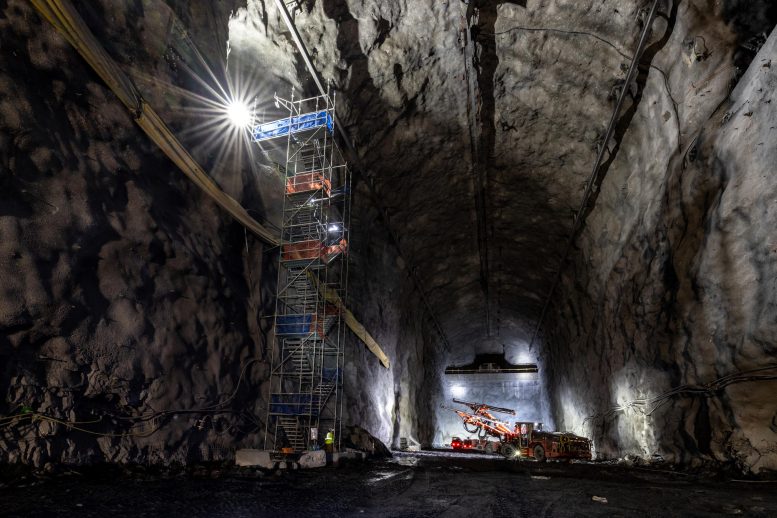Massive Underground Caverns Unearthed for Groundbreaking DUNE Neutrino Project

Two immense underground caverns, each stretching over 500 feet long and approximately the height of a seven-story building, have been constructed by workers for the Deep Underground Neutrino Experiment's massive particle detector modules. Fermilab hosts the project. A third cavern will contain the utilities needed for the operation of the detector. The images were credited to Matthew Kapust of the Sanford Underground Research Facility.
The completion of these significant subterranean caves for the Deep Underground Neutrino Experiment (DUNE) opens the way for innovative study of neutrinos. An international ensemble of over 1400 scientists and engineers will participate in this momentous research.
The projected location for the huge particle detectors of the global Deep Underground Neutrino Experiment has been fully excavated by workers. Situated a mile under the Earth's surface, the immense caverns form the central part of a new research facility that covers an underground area about the size of eight soccer fields.
The DUNE project is hosted by the Fermi National Accelerator Laboratory, managed by the U.S. Department of Energy. Here, DUNE scientists will analyze the obscure neutrinos' behavior to resolve some of the universe's most complex queries. They aim to explore why the universe is made up of matter, how an exploding star can form a black hole, and finally, the potentially undiscovered connection of neutrinos with dark matter or other unknown particles.
The caverns will house four large neutrino detectors, each roughly the size of a seven-story building. These detectors will be filled with liquid argon to record the infrequent interaction of neutrinos with the transparent liquid.
DUNE seeks to deliver an improved understanding of our universe. Three primary science goals drive the researchers: to explore whether neutrinos are the reason the universe is made of matter; to uncover subatomic phenomena that could unite force fields according to Einstein's theory; and to track neutrinos from exploding stars, potentially witnessing the commencement of a neutron star or a black hole.
Without human awareness, trillions of neutrinos pass through our bodies every second. DUNE scientists will observe neutrinos from exploding stars and inspect the behavior a beam of neutrinos produced at Fermilab. Situated near Chicago and approximately 800 miles east of the subterranean caverns, Fermilab hosts the world's most powerful neutrino source. Neutrinos path from Fermilab to the South Dakota-based DUNE detectors, traversing solid ground and rock, requires no tunnel.
U.S. Project Director Chris Mossey notes the completion of these huge caverns' excavation as a remarkable milestone for the project. This accomplishment preps the project for detector installation later in the year, working towards transforming the top-tier underground facility vision into a reality.
A conveyor transported nearly 800,000 tons of excavated rock from a mile underground into the Open Cut in Lead, South Dakota. The image was credited to Stephen Kenny from Sanford Underground Research Facility.
Since 2021, Engineering, construction and excavation teams have been working at 4,850 feet below ground level at the Sanford Underground Research Facility, which hosts the South Dakota part of DUNE. The construction teams dismantled heavy mining equipment and transported the parts into the underground workplace via an existing shaft. The equipment was reassembled underground and approximately two years were dedicated to blasting and removing rock. Almost 800,000 tons of rock were excised and moved from the underground site into an extensive on-ground former mining area, the Open Cut.
The workers will commence outfitting the caverns with the necessary systems for the installation of the DUNE detectors and the routine operation of the research facility. The insulated steel framework, which will support the first neutrino detector, is planned to be installed by the project team later in the year. The aim is to make the first detector operational before the conclusion of 2028.
An aerial view illustrates the enormity of one of the large caverns in South Dakota, roughly the size of a seven-story building. The cavern will host large particle detectors for the Deep Underground Neutrino Experiment to explore neutrino behavior. The DUNE detectors are anticipated to be the world's largest underground cryogenic systems. The image was credited to Matthew Kapust from the Sanford Underground Research Facility.
“The completion of the three large caverns and all of the interconnecting drifts marks the end of a really big dig. The excavation contractor maintained an exemplary safety record working over a million hours without a lost-time accident. That’s a major achievement in this heavy construction industry,” said Fermilab’s Michael Gemelli, who managed the excavation of the caverns by Thyssen Mining. “The success of this phase of the project can be attributed to the safe, dedicated work of the excavation workers, the multi-disciplined backgrounds of the project engineers and support personnel. What a remarkable achievement and milestone for this international project.”
DUNE scientists are eager to start the installation of the particle detectors. The DUNE collaboration, which includes more than 1,400 scientists and engineers from over 200 institutions in 36 countries, has successfully tested the technology and assembly process for the first detector. Mass production of its components has begun. Testing of the technologies underlying both detectors is underway using particle beams at the European laboratory CERN.




